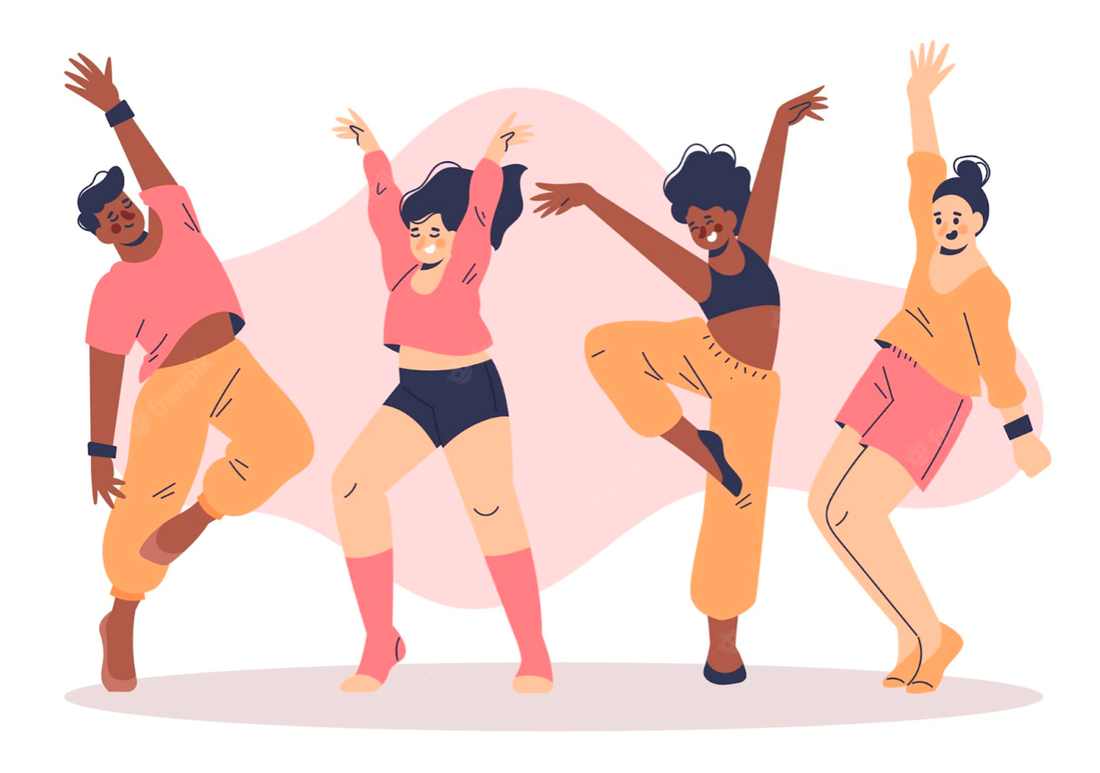|
Written by Shenna Dunn What’s your favourite form of physical activity? I prefer dancing - the ultimate combination of physicality and artistic expression. Of course, I may be a little biased, seeing as I have danced extensively in my lifetime and currently work as a dance instructor. But hear me out.
Dance participation, and performing arts in general, is increasingly recognised for the health benefits it can yield. Recent reviews across many outcomes indicate dance participation as a promising avenue to improve fitness, mental health, and social connection. A single dance session can improve your mood. Weekly dancing can improve strength, endurance, balance, mobility, and even sleep quality. The social aspect of shared movement and creative expression is also important, with dance classes providing social connection and support. These psychosocial factors can also serve to improve mental health and wellbeing. Plus, dance can be easier to engage in than a regular workout - physical exertion is a byproduct of the movements in dance rather than the main goal. And we know how important physical activity is, having been shown to reduce your risk of mortality between 9 to 39%, and serving as a preventative measure for many chronic medical conditions. In fact, moderate intensity dancing appears to have better cardiovascular benefits than moderate intensity walking, lowering risk of death due to cardiovascular problems. Just sixty minutes of weekly performing arts participation has been associated with positive health effects, including improved mental health and wellbeing, physical fitness, and cognitive function. A recent study among university students in China found that those who engaged in regular dance classes had lower rates of depression, even after adjustment for other risk factors associated with depression (e.g. alcohol consumption, diet). This indicates dance may be a protective factor against depression, and suggests regular dance classes could be a possible intervention to improve mental health among students. It is thought that dance provides an effective outlet for stress and adaptation for chronic stressors we experience in our day-to-day lives, perhaps due to the social support and entertainment it provides. Dance classes appear to be easier for people to adhere to in the longer term than other forms of exercise, which can contribute to the long-term benefits seen. Dance involves purposeful, rhythmic, and patterned body movements, and can be used to express ideas or emotions, release energy, or as meditative practice. Some form of dancing is found in every culture, and is an essentially universal language. It is thought that dance has existed as long as us humans have, coming before ancient music and painting. It is as innate to you and I as walking and breathing, even if you don’t feel coordinated when you’re on the dance floor. Dance takes many forms, from traditional cultural dances, to classical ballet, jazz, hip hop, and more. So really, there’s a form of dance to suit everyone, whether you enjoy the crisp moves of commercial classes, free-flowing contemporary, or the latest TikTok dance trend. Dance interventions are currently being explored for improving certain conditions. For example, ‘Dancing With Parkinson’s’ is an initiative that works to provide dance classes to people with Parkinson’s disease. Dance has been shown to significantly improve their balance, coordination and quality of life. It can help with motor function and proprioception, which are affected in neurodegenerative diseases. Dance also shows promise for other neurological conditions; people recovering from stroke, and those with multiple sclerosis or Huntington’s disease have seen improved balance, gait, and mobility, after participating in dance interventions. People with lung diseases found their breathing ability improved after taking a course of dance lessons. Older adults benefit from dance as a community activity. Dance has even been used as an intervention in women after breast cancer treatment, resulting in improved fitness, as well as emotional and social wellbeing, helping general quality of life. With creative, social, and physical benefits, dance could become a multi-faceted method to improve health. So whether you engage in structured classes (check out Queen’s Dance Club!), jam out to some tunes from time to time, or hit up Stage Rage on a Thursday night, adding some dance to your week can only be beneficial! References Clifford, A. M., Shanahan, J., McKee, J., Cleary, T., O’Neill, A., O’Gorman, M., ... & Ní Bhriain, O. (2022). The effect of dance on physical health and cognition in community dwelling older adults: a systematic review and meta-analysis. Arts & Health, 1-29. Drinkwater, C., Wildman, J., & Moffatt, S. (2019). Social prescribing. BMJ (Clinical research ed.), 364, l1285. https://doi.org/10.1136/bmj.l1285 Fink, B., Bläsing, B., Ravignani, A., & Shackelford, T. K. (2021). Evolution and functions of human dance. Evolution and Human Behavior, 42(4), 351-360. Karkou, V., Dudley-Swarbrick, I., Starkey, J., Parsons, A., Aithal, S., Omylinska-Thurston, J., ... & Parisi, A. (2021). Dancing with health: quality of life and physical improvements from an EU Collaborative Dance Programme with women following breast cancer treatment. Frontiers in Psychology, 12, 635578. McCrary, J. M., Redding, E., & Altenmüller, E. (2021). Performing arts as a health resource? An umbrella review of the health impacts of music and dance participation. PloS one, 16(6), e0252956. McKenzie, K., Bowes, R., & Murray, K. (2021). Effects of dance on mood and potential of dance as a mental health intervention. Mental Health Practice, 24(3). Merom, D., Ding, D., & Stamatakis, E. (2016). Dancing participation and cardiovascular disease mortality: a pooled analysis of 11 population-based British cohorts. American journal of preventive medicine, 50(6), 756-760. Niranjan, V., Tarantino, G., Kumar, J., Stokes, D., O’Connor, R., & O’Regan, A. (2022). The Impact of Dance Interventions on Patients with Noninfectious Pulmonary Diseases: A Systematic Review. International journal of environmental research and public health, 19(17), 11115. O'Cadiz, D. (2021). Dance and Cultural Diversity. Cognella Academic Publishing Patterson, K. K., Wong, J. S., Prout, E. C., & Brooks, D. (2018). Dance for the rehabilitation of balance and gait in adults with neurological conditions other than Parkinson's disease: a systematic review. Heliyon, 4(3), e00584. Sharp, K., & Hewitt, J. (2014). Dance as an intervention for people with Parkinson's disease: a systematic review and meta-analysis. Neuroscience & Biobehavioral Reviews, 47, 445-456. Zhang, L., Zhao, S., Weng, W., Lin, Q., Song, M., Wu, S., & Zheng, H. (2021). Frequent sports dance may serve as a protective factor for depression among college students: a real-world data analysis in China. Psychology research and behavior management, 14, 405.
0 Comments
|
Categories |







 RSS Feed
RSS Feed